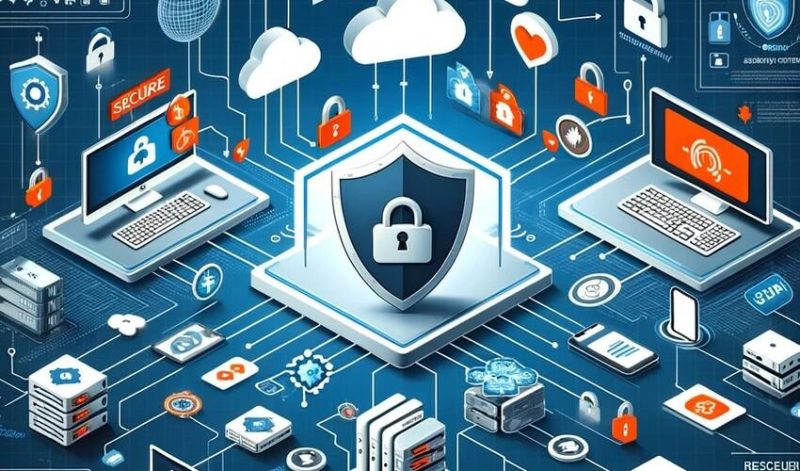
Top Secure IT Solutions for Modern Businesses
In the rapidly evolving digital landscape, businesses face various cybersecurity threats that can compromise sensitive data, disrupt operations, and damage reputations. To counter these challenges, implementing robust and secure IT solutions is paramount. This article explores modern businesses’ top secure IT solutions, focusing on strategies and technologies that ensure data integrity, privacy, and protection against cyber threats.
Understanding Secure IT Solutions
A secure IT solution encompasses a range of technologies, practices, and policies designed to protect digital assets from unauthorized access, cyberattacks, and other security risks. These solutions are critical for safeguarding sensitive business information, maintaining regulatory compliance, and ensuring the continuity of operations.
Key Secure IT Solutions for Modern Businesses
1. Endpoint Security
Endpoint security protects devices like computers, smartphones, and tablets connected to the corporate network. As endpoints are often the primary targets for cyberattacks, robust endpoint security is essential.
Components of Endpoint Security:
- Antivirus and Antimalware: Detects and removes malicious software.
- Firewalls: Monitors and controls incoming and outgoing network traffic.
- Intrusion Detection Systems (IDS): Identifies and responds to potential threats.
- Endpoint Detection and Response (EDR): Provides real-time monitoring and response to advanced threats.
2. Network Security
Network security focuses on protecting the integrity and usability of data as it travels across networks. It involves a combination of hardware and software solutions to prevent unauthorized access and misuse.
Key Network Security Solutions:
- Virtual Private Networks (VPNs): Encrypts internet connections, ensuring secure remote access.
- Network Access Control (NAC): Restricts network access to authorized users and devices.
- Secure Web Gateways: Protects against web-based threats by filtering malicious content.
- Unified Threat Management (UTM): Integrates multiple security functions, such as firewalls, intrusion prevention, and antivirus, into a single platform.
3. Cloud Security
With the increasing adoption of cloud services, cloud security has become a critical component of IT security strategies. It encompasses policies, technologies, and controls to protect data and applications hosted in the cloud.
Essential Cloud Security Measures:
- Encryption: Ensures data is encrypted both at rest and in transit.
- Identity and Access Management (IAM): Manages user identities and access to cloud resources.
- Security Information and Event Management (SIEM): Provides real-time analysis of security alerts generated by cloud applications.
- Cloud Access Security Brokers (CASB): Enforces security policies and compliance across cloud services.
4. Data Protection and Encryption
Data protection and encryption are fundamental to ensuring that sensitive information remains secure within and outside the organization. Encryption transforms data into an unreadable format, making it inaccessible to unauthorized users.
Key Data Protection Strategies:
- Encryption at Rest and in Transit: Protects data stored on devices and transmitted over networks.
- Data Loss Prevention (DLP): Monitors and protects data from unauthorized access or accidental exposure.
- Backup and Recovery Solutions: These regularly back up data and provide mechanisms for data recovery in case of loss or corruption.
- Tokenization: Replaces sensitive data with unique identification symbols that retain essential information without compromising security.
5. Identity and Access Management (IAM)
IAM is a framework of policies and technologies that ensures the right individuals access the right resources at the right times for the right reasons. It is crucial for managing user identities and controlling access to critical business systems and data.
Components of IAM:
- Single Sign-On (SSO): Allows users to log in once and gain access to multiple applications.
- Multi-Factor Authentication (MFA): Requires multiple verification forms to authenticate users.
- Role-Based Access Control (RBAC): Assigns access rights based on user roles within the organization.
- Privileged Access Management (PAM): Controls and monitors access by privileged users.
6. Security Awareness Training
Security awareness training educates employees about cybersecurity risks and best practices. Human error is a significant factor in many security breaches, making training an essential element of any secure IT solution.
Elements of Security Awareness Training:
- Phishing Simulation: Tests employees’ ability to recognize and respond to phishing attempts.
- Regular Training Sessions: Keeps employees informed about the latest threats and security practices.
- Policy Education: Ensures employees understand the organization’s security policies and procedures.
- Incident Response Drills: Prepares employees to respond effectively to security incidents.
7. Incident Response and Management
Incident response and management involve preparing for, detecting, and responding to security incidents. A well-defined incident response plan helps minimize damage and recover quickly from security breaches.
Key Components of Incident Response:
- Preparation: Develop and test incident response plans and protocols.
- Detection and Analysis: Identifies and assesses security incidents in real time.
- Containment and Eradication: Isolates and eliminates the threat to prevent further damage.
- Recovery: Restores affected systems and data to normal operation.
- Post-Incident Review: Analyzes the incident to improve future response efforts.
8. Regulatory Compliance
Compliance with industry regulations and standards is a critical aspect of IT security. Regulatory compliance ensures that organizations adhere to legal requirements and best data protection and security practices.
Important Regulations and Standards:
- General Data Protection Regulation (GDPR): Protects the privacy of individuals in the European Union.
- Health Insurance Portability and Accountability Act (HIPAA): Protects sensitive patient health information.
- Payment Card Industry Data Security Standard (PCI DSS): Ensures the secure handling of credit card information.
- Sarbanes-Oxley Act (SOX): Protects shareholders and the general public from accounting errors and fraudulent practices.
Conclusion
Implementing secure IT solutions is essential for modern businesses to protect their digital assets, maintain regulatory compliance, and ensure the continuity of operations. Businesses can build a comprehensive security framework by integrating robust endpoint security, network security, cloud security, data protection, IAM, security awareness training, incident response, and regulatory compliance measures. These secure IT solutions safeguard against cyber threats and enhance overall business resilience and trust.
Zainab Afzal is a senior SEO Consultant and Writer. She has 5+ years of experience in Digital Marketing. After completing his degree in BS computer science, she has worked with different IT companies.
